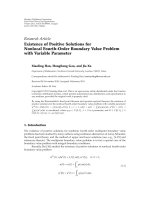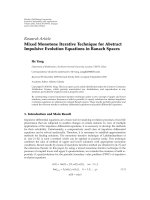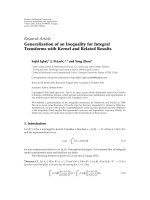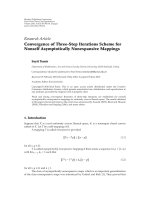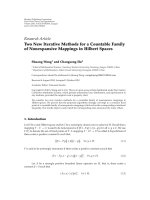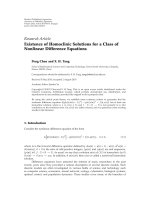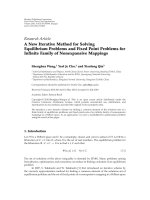Báo cáo hóa học: " Research Article Convergence of Iterative Sequences for Fixed Point and Variational Inclusion Problems" pot
Bạn đang xem bản rút gọn của tài liệu. Xem và tải ngay bản đầy đủ của tài liệu tại đây (514.86 KB, 15 trang )
Hindawi Publishing Corporation
Fixed Point Theory and Applications
Volume 2011, Article ID 368137, 15 pages
doi:10.1155/2011/368137
Research Article
Convergence of Iterative Sequences for Fixed Point
and Variational Inclusion Problems
Li Yu and Ma Liang
School of Management, University of Shanghai for Science and Technology, Shanghai 200093, China
Correspondence should be addressed to Li Yu,
Received 14 November 2010; Accepted 8 February 2011
Academic Editor: Yeol J. Cho
Copyright q 2011 L. Yu and M. Liang. This is an open access article distributed under the Creative
Commons Attribution License, which permits unrestricted use, distribution, and reproduction in
any medium, provided the original work is properly cited.
An iterative process is considered for finding a common element in the fixed point set of a strict
pseudocontraction and in the zero set of a nonlinear mapping which is the sum of a maximal
monotone operator and an inverse strongly monotone mapping. Strong convergence theorems of
common elements are established in real Hilbert spaces.
1. Introduction and Preliminaries
Throughout this paper, we always assume that H is a real Hilbert space with the inner
product ·, · and the norm ·.
Let C be a nonempty closed convex subset of H and S : C → C a nonlinear mapping.
In this paper, we use FS to denote the fixed point set of S. Recall that the mapping S is said
to be nonexpansive if
Sx − Sy≤x − y, ∀x, y ∈ C. 1.1
S is said to be κ-strictly pseudocontractive if there exists a constant κ ∈ 0, 1 such that
Sx − Sy
2
≤
x − y
2
κ
x − Sx
−
y − Sy
2
, ∀x, y ∈ C.
1.2
The class of strictly pseudocontractive mappings was introduced by Browder and Petryshyn
1 in 1967. It is easy to see that every nonexpansive mapping is a 0-strictly pseudocontractive
mapping.
2 Fixed Point Theory and Applications
Let A : C → H be a mapping. Recall that A is said to be monotone if
Ax − Ay, x − y
≥ 0, ∀x, y ∈ C. 1.3
A is said to be inverse strongly monotone if there exists a constant α>0 such that
Ax − Ay, x − y≥α
Ax − Ay
2
, ∀x, y ∈ C.
1.4
For such a case, A is also said to be α-inverse strongly monotone.
Let M : H → 2
H
be a set-valued mapping. The set DM defined by DM{x ∈ H :
Mx
/
∅} is said to be the domain of M.ThesetRM defined by RM
x∈H
Mx is said to
be the range of M.ThesetGM defined by GM{x, y ∈ H × H : x ∈ DM,y ∈ RM}
is said to be the graph of M.
Recall that M is said to be monotone if
x − y, f − g
> 0, ∀
x, f
,
y, g
∈ G
M
. 1.5
M is said to be maximal monotone if it is not properly contained in any other monotone
operator. Equivalently, M is maximal monotone if RI rMH for all r>0. For a maximal
monotone operator M on H and r>0, we may define the single-valued resolvent J
r
I rM
−1
: H → DM. It is known that J
r
is firmly nonexpansive and M
−1
0FJ
r
.
Recall that the classical variational inequality problem is to find x ∈ C such that
Ax, y − x
≥ 0, ∀y ∈ C. 1.6
Denote by VIC, A of the solution set of 1.6. It is known that x ∈ C is a solution to 1.6 if
and only if x is a fixed point of the mapping P
C
I − λA, where λ>0 is a constant and I is the
identity mapping.
Recently, many authors considered the convergence of iterative sequences for the
variational inequality 1.6 and fixed point problems of nonlinear mappings see, for example,
1–32.
In 2005, Iiduka and Takahashi 7 proved the following theorem.
Theorem IT. Let C be a closed convex subset of a real Hilbert space H.LetA be an α-inverse-
strongly monotone mapping of C into H, and let S be a nonexpansive mapping of C into itself such
that FS ∩ VIC, A
/
∅. Suppose that x
1
x ∈ C and {x
n
} is given by
x
n1
α
n
x
1 − α
n
SP
C
x
n
− λ
n
Ax
n
, 1.7
for every n 1, 2, ,where{α
n
} is a sequence in 0, 1 and {λ
n
} is a sequence in a, b.If{α
n
} and
{λ
n
} are chosen so that {λ
n
}∈a, b for some a, b with 0 <a<b<2α,
lim
n →∞
α
n
0,
∞
n1
α
n
∞,
∞
n1
|
α
n1
− α
n
|
< ∞,
∞
n1
|
λ
n1
− λ
n
|
< ∞,
1.8
then {x
n
} converges strongly to P
FS∩VIC,A
x.
Fixed Point Theory and Applications 3
In 2007, Y. Yao and J C. Yao 31 further obtained the following theorem.
Theorem YY. Let C be a closed convex subset of a real Hilbert space H.LetA be an α-inverse-
strongly monotone mapping of C into H, and let S be a nonexpansive mapping of C into itself such
that FS ∩ Ω
/
∅,whereΩ denotes the set of solutions of a variational inequality for the α-inverse-
strongly monotone mapping. Suppose that x
1
u ∈ C and {x
n
}, {y
n
} are given by
x
1
u ∈ C,
y
n
P
C
x
n
− λ
n
Ax
n
,
x
n1
α
n
u β
n
x
n
γ
n
SP
C
I − λ
n
A
y
n
,n≥ 1,
1.9
where {α
n
}, {β
n
}, and {γ
n
} are three sequences in 0, 1 and {λ
n
} is a sequence in 0, 2a.If{α
n
},
{β
n
}, {γ
n
}, and {λ
n
} are chosen so that λ
n
∈ a, b for some a, b with 0 <a<b<2a and
a α
n
β
n
γ
n
1, for all n ≥ 1,
b lim
n →∞
α
n
0,
∞
n1
α
n
∞,
c 0 < lim inf
n →∞
β
n
≤ lim sup
n →∞
β
n
< 1,
d lim
n →∞
λ
n1
− λ
n
0,
then {x
n
} converges strongly to P
FS∩Ω
u.
In this work, motivated by the above results, we consider the problem of finding a
common element in the fixed point set of a strict pseudocontraction and in the zero set of a
nonlinear mapping which is the sum of a maximal monotone operator and a inverse strongly
monotone mapping. Strong convergence theorems of common elements are established in
real Hilbert spaces. The results presented in this paper improve and extend the corresponding
results announced by Iiduka and Takahashi 7 and Y. Yao and J C. Yao 31.
In order to prove our main results, we also need the following lemmas.
Lemma 1.1 see 22. Let C be a nonempty closed convex subset of a Hilbert space H, A : C → H
a mapping, and M : H → 2
H
a maximal monotone mapping. Then,
F
J
r
I − rA
A M
−1
0
, ∀r>0.
1.10
Lemma 1.2 see 1. Let C be a nonempty closed convex subset of a real Hilbert space H and S :
C → C a κ-strict pseudocontraction with a fixed point. Define S : C → C by S
a
x ax 1 − aSx
for each x ∈ C.Ifa ∈ κ, 1,thenS
a
is nonexpansive with FS
a
FS.
Lemma 1.3 see 25. Let C be a nonempty closed convex subset of a Hilbert space H and S : C →
C a κ-strict pseudocontraction. Then,
a S is 1 κ/1 − κ-Lipschitz,
b I − S is demi-closed, this is, if {x
n
} is a sequence in C with x
n
xand x
n
− Sx
n
→ 0,
then x ∈ FS.
4 Fixed Point Theory and Applications
Lemma 1.4 see 28. Let {x
n
} and {y
n
} be bounded sequences in a Hilbert space H, and let {β
n
}
be a sequence in 0, 1 with
0 < lim inf
n →∞
β
n
≤ lim sup
n →∞
β
n
< 1.
1.11
Suppose that x
n1
1 − β
n
y
n
β
n
x
n
for all integers n ≥ 1 and
lim sup
n →∞
y
n1
− y
n
−x
n1
− x
n
≤ 0.
1.12
Then, lim
n →∞
y
n
− x
n
0.
Lemma 1.5 see 29. Assume that {α
n
} is a sequence of nonnegative real numbers such that
α
n1
≤
1 − γ
n
α
n
δ
n
, 1.13
where {γ
n
} is a sequence in 0, 1 and {δ
n
} is a sequence such that
a
∞
n1
γ
n
∞,
b lim sup
n →∞
δ
n
/γ
n
≤ 0 or
∞
n1
|δ
n
| < ∞.
Then, lim
n →∞
α
n
0.
Lemma 1.6 see 24. Let H be a Hilbert space and M a maximal monotone operator on H. Then,
the following holds:
J
r
x − J
s
x
2
≤
r − x
r
J
r
x − J
s
x, J
r
x − x
, ∀s, t > 0,x∈ H,
1.14
where J
r
I rM
−1
and J
s
I sM
−1
.
2. Main Results
Theorem 2.1. Let H be a real Hilbert space H and C a nonempty close and convex subset of H.Let
M : H → 2
H
and W : H → 2
H
two maximal monotone operators such that DM ⊂ C and
DW ⊂ C, respectively. Let S : C → C be a κ-strict pseudocontraction, A : C → H an α-inverse
strongly monotone mapping, and B : C → H a β-inverse strongly monotone mapping. Assume that
F : FS ∩ A M
−1
0 ∩ B W
−1
0
/
∅.Let{x
n
} be a sequence generated in the following
manner:
x
1
∈ C,
y
n
J
s
n
x
n
− s
n
Bx
n
,
x
n1
α
n
u β
n
x
n
γ
n
δ
n
J
r
n
y
n
− r
n
Ay
n
1 − δ
n
SJ
r
n
y
n
− r
n
Ay
n
, ∀n ≥ 1,
2.1
where u ∈ C is a fixed element, J
r
n
I r
n
M
−1
and J
s
n
I s
n
W
−1
, {r
n
} is a sequence
in 0, 2α, {s
n
} is a sequence in 0, 2β and {α
n
}, {β
n
}, {γ
n
}, and {δ
n
} are sequences in 0, 1.
Fixed Point Theory and Applications 5
Assume that the following restrictions are satisfied:
a 0 <a≤ r
n
≤ b<2α, lim
n →∞
r
n
− r
n1
0,
b 0 <c≤ s
n
≤ d<2β
n
, lim
n →∞
s
n
− s
n1
0,
c 0 ≤ κ ≤ δ
n
<e<1, lim
n →∞
δ
n
− δ
n1
0,
d lim
n →∞
α
n
0,
∞
n1
α
n
∞,
e 0 < lim inf
n →∞
β
n
≤ lim inf
n →∞
β
n
< 1.
Then, the sequence {x
n
} converges strongly to q P
F
u.
Proof. The proof is split into five steps.
Step 1. Show that {x
n
} is bounded.
Note that I − r
n
A and I − s
n
B are nonexpansive for each fixed n ≥ 1. Indeed, we see
from the restriction a that
I − r
n
Ax −
I − r
n
A
y
2
x − y
2
− 2r
n
x − y, Ax − Ay
r
2
n
Ax − Ay
2
≤
x − y
2
− r
n
2α − r
n
Ax − Ay
2
≤
x − y
2
, ∀x, y ∈ C.
2.2
This shows that I − r
n
A is nonexpansive f or each fixed n ≥ 1, so is I − s
n
B.Put
S
n
x δ
n
x
1 − δ
n
Sx, ∀x ∈ C. 2.3
In view of the restriction c,weobtainfromLemma 1.2 that S
n
is a nonexpansive mapping
with FS
n
FS for each fixed n ≥ 1. Fixing p ∈Fand since J
r
n
and I − r
n
A are
nonexpansive, we see that
x
n1
− p≤α
n
u − p β
n
x
n
− p γ
n
S
n
J
r
n
y
n
− r
n
Ay
n
− p
≤ α
n
u − p β
n
x
n
− p γ
n
J
r
n
y
n
− r
n
Ay
n
− p
≤ α
n
u − p β
n
x
n
− p γ
n
y
n
− p
≤ α
n
u − p
1 − α
n
x
n
− p.
2.4
By mathematical inductions, we see that {x
n
} is bounded and so is {y
n
}. This completes
Step 1.
6 Fixed Point Theory and Applications
Step 2. Show that x
n1
− x
n
→0asn →∞.
Notice from Lemma 1.6 that
y
n1
− y
n
≤
x
n1
− s
n1
Bx
n1
−
x
n
− s
n
Bx
n
J
s
n1
x
n
− s
n
Bx
n
− J
s
n
x
n
− s
n
Bx
n
≤x
n1
− x
n
|
s
n1
− s
n
|
Bx
n
|
s
n1
− s
n
|
s
n1
J
s
n1
x
n
− s
n
Bx
n
−
x
n
− s
n
Bx
n
≤x
n1
− x
n
2M
1
|
s
n1
− s
n
|
,
2.5
where M
1
is an appropriate constant such that
M
1
max
sup
n≥1
{
Bx
n
}
, sup
n≥1
J
s
n1
x
n
− s
n
Bx
n
−
x
n
− s
n
Bx
n
s
n1
. 2.6
Put
z
n
J
r
n
y
n
− r
n
Ay
n
, ∀n ≥ 1. 2.7
In a similar way, we can obtain from Lemma 1.6 that
z
n1
− z
n
≤
y
n1
− r
n1
Ay
n1
−
y
n
− r
n
Ay
n
J
r
n1
y
n
− r
n
Ay
n
− J
r
n
y
n
− r
n
Ay
n
≤
y
n1
−−y
n
|
r
n1
− r
n
|
Ay
n
|
r
n1
− r
n
|
r
n1
J
r
n1
y
n
− r
n
Ay
n
−
y
n
− r
n
Ay
n
≤y
n1
− y
n
2M
2
|
r
n1
− r
n
|
,
2.8
where M
2
is an appropriate constant such that
M
2
max
sup
n≥1
Ay
n
, sup
n≥1
J
r
n1
y
n
− r
n
Ax
n
−
y
n
− r
n
Ay
n
r
n1
. 2.9
Substituting 2.5 into 2.8 yields that
z
n1
− z
n
≤x
n1
− x
n
M
3
|
s
n1
− s
n
|
|
r
n1
− r
n
|
, 2.10
Fixed Point Theory and Applications 7
where M
3
is an appropriate constant such that
M
3
max
{
2M
1
, 2M
2
}
. 2.11
It follows from 2.10 that
S
n1
z
n1
− S
n
z
n
≤z
n1
− z
n
z
n
− Sz
n
|
δ
n
− δ
n1
|
≤x
n1
− x
n
M
4
|
s
n1
− s
n
|
|
r
n1
− r
n
|
|
δ
n
− δ
n1
|
,
2.12
where M
4
is an appropriate constant such that
M
4
max
sup
n≥1
{
z
n
− Sz
n
}
,M
3
. 2.13
Put
l
n
x
n1
− β
n
x
n
1 − β
n
, ∀n ≥ 1.
2.14
Note that
l
n1
− l
n
α
n1
u γ
n1
S
n1
z
n1
1 − β
n1
−
α
n
u γ
n
S
n
z
n
1 − β
n
α
n1
1 − β
n1
−
α
n
1 − β
n
u
γ
n1
1 − β
n1
S
n1
z
n1
− S
n
z
n
γ
n1
1 − β
n1
−
γ
n
1 − β
n
S
n
z
n
α
n1
1 − β
n1
−
α
n
1 − β
n
u − S
n
z
n
γ
n1
1 − β
n1
S
n1
z
n1
− S
n
z
n
.
2.15
It follows from 2.12 that
l
n1
− l
n
≤
α
n1
1 − β
n1
−
α
n
1 − β
n
u − S
n
z
n
γ
n1
1 − β
n1
S
n1
z
n1
− S
n
z
n
≤
α
n1
1 − β
n1
−
α
n
1 − β
n
u − S
n
z
n
x
n1
− x
n
M
4
|
s
n1
− s
n
|
|
r
n1
− r
n
|
|
δ
n
− δ
n1
|
.
2.16
This in turn implies from the restrictions a–e that
lim sup
n →∞
l
n1
− l
n
−
x
n1
− x
n
≤ 0.
2.17
8 Fixed Point Theory and Applications
From Lemma 1.4,weobtainthat
lim
n →∞
l
n
− x
n
0.
2.18
Notice that
x
n1
− x
n
1 − β
n
l
n
− x
n
. 2.19
It follows that
lim
n →∞
x
n1
− x
n
0.
2.20
This completes Step 2.
Step 3. Show that x
n
− Sx
n
→0asn →∞.
Since J
r
n
and J
s
n
are nonexpansive, we see that
z
n
− p
2
≤
x
n
− p
2
− r
n
2α − r
n
Ay
n
− Ap
2
,
2.21
y
n
− p
2
≤
x
n
− p
2
− s
n
2β − s
n
Bx
n
− Bp
2
.
2.22
It follows from 2.21 that
x
n1
− p
2
≤ α
n
u − p
2
β
n
x
n
− p
2
γ
n
S
n
z
n
− p
2
≤ α
n
u − p
2
β
n
x
n
− p
2
γ
n
z
n
− p
2
≤ α
n
u − p
2
x
n
− p
2
− γ
n
r
n
2α − r
n
Ay
n
− Ap
2
.
2.23
This in turn implies that
γ
n
r
n
2α − r
n
Ay
n
− Ap
2
≤ α
n
u − p
2
x
n
− x
n1
x
n
− p x
n1
− p
.
2.24
In view of 2.20, we see from the restrictions a, d,ande that
lim
n →∞
Ay
n
− Ap 0.
2.25
Fixed Point Theory and Applications 9
It follows from 2.22 that
x
n1
− p
2
≤ α
n
u − p
2
β
n
x
n
− p
2
γ
n
S
n
z
n
− p
2
≤ α
n
u − p
2
β
n
x
n
− p
2
γ
n
J
r
n
y
n
− r
n
Ay
n
− p
2
≤ α
n
u − p
2
β
n
x
n
− p
2
γ
n
y
n
− p
2
≤ α
n
u − p
2
x
n
− p
2
− γ
n
s
n
2β − s
n
Bx
n
− Bp
2
.
2.26
This in turn implies that
γ
n
s
n
2β − s
n
Bx
n
− Bp
2
≤ α
n
u − p
2
x
n
− x
n1
x
n
− p x
n1
− p
.
2.27
In view of 2.20, we see from the restrictions a, d,ande that
lim
n →∞
Bx
n
− Bp 0.
2.28
Since J
r
n
is firmly nonexpansive, we obtain that
z
n
− p
2
J
r
n
y
n
− r
n
Ay
n
− J
r
n
p − r
n
Ap
2
≤
z
n
− p,
y
n
− r
n
Ay
n
−
p − r
n
Ap
1
2
z
n
− p
2
y
n
− r
n
Ay
n
− p − r
n
Ap
2
−
z
n
− p
−
y
n
− r
n
Ay
n
−
p − r
n
Ap
2
≤
1
2
z
n
− p
2
y
n
− p
2
−
z
n
− y
n
r
n
Ay
n
− Ap
2
1
2
z
n
− p
2
y
n
− p
2
−
z
n
− y
n
2
− r
2
n
Ay
n
− Ap
2
−2r
n
z
n
− y
n
,Ay
n
− Ap
≤
1
2
z
n
− p
2
y
n
− p
2
−
z
n
− y
n
2
2r
n
z
n
− y
n
Ay
n
− Ap
≤
1
2
z
n
− p
2
x
n
− p
2
−
z
n
− y
n
2
2r
n
z
n
− y
n
Ay
n
− Ap
.
2.29
This in turn implies that
z
n
− p
2
≤
x
n
− p
2
−
z
n
− y
n
2
2r
n
z
n
− y
n
Ay
n
− Ap.
2.30
10 Fixed Point Theory and Applications
In a similar way, we can obtain that
y
n
− p
2
≤
x
n
− p
2
−
y
n
− x
n
2
2s
n
y
n
− x
n
Bx
n
− Bp.
2.31
In view of 2.30,weseethat
x
n1
− p
2
≤ α
n
u − p
2
β
n
x
n
− p
2
γ
n
S
n
z
n
− p
2
≤ α
n
u − p
2
β
n
x
n
− p
2
γ
n
z
n
− p
2
≤ α
n
u − p
2
x
n
− p
2
− γ
n
z
n
− y
n
2
2r
n
z
n
− y
n
Ay
n
− Ap.
2.32
It follows that
γ
n
z
n
− y
n
2
≤ α
n
u − p
2
x
n
− x
n1
x
n
− p x
n1
− p
2r
n
z
n
− y
n
Ay
n
− Ap.
2.33
In view of 2.25, we obtain from the restrictions d and e that
lim
n →∞
z
n
− y
n
0.
2.34
Notice from 2.31,weseethat
x
n1
− p
2
≤ α
n
u − p
2
β
n
x
n
− p
2
γ
n
S
n
z
n
− p
2
≤ α
n
u − p
2
β
n
x
n
− p
2
γ
n
z
n
− p
2
≤ α
n
u − p
2
β
n
x
n
− p
2
γ
n
y
n
− p
2
≤ α
n
u − p
2
x
n
− p
2
− γ
n
y
n
− x
n
2
2s
n
y
n
− x
n
Bx
n
− Bp.
2.35
It follows that
γ
n
y
n
− x
n
2
≤ α
n
u − p
2
x
n
− x
n1
x
n
− p x
n1
− p
2s
n
y
n
− x
n
Bx
n
− Bp.
2.36
In view of 2.28, we obtain from the restrictions d and e that
lim
n →∞
y
n
− x
n
0.
2.37
Fixed Point Theory and Applications 11
Combining 2.34 with 2.37 yields that
lim
n →∞
z
n
− x
n
0.
2.38
Note that
x
n1
− x
n
α
n
u − x
n
γ
n
S
n
z
n
− x
n
. 2.39
In view of 2.20, we see from the restriction d that
lim
n →∞
S
n
z
n
− x
n
0.
2.40
Note that
Sz
n
− x
n
S
n
z
n
− x
n
1 − δ
n
δ
n
x
n
− z
n
1 − δ
n
.
2.41
From 2.38 and 2.40, we get from the restriction c that
lim
n →∞
Sz
n
− x
n
0.
2.42
Notice that
Sx
n
− x
n
≤
Sx
n
− Sz
n
Sz
n
− x
n
. 2.43
In view of 2.38 and 2.42,weseefromLemma 1.3 that
lim
n →∞
Sx
n
− x
n
0.
2.44
This completes Step 3.
Step 4. Show that lim sup
n →∞
u − q, x
n
− q≤0, where q P
F
u.
To show it, we may choose a subsequence {x
n
i
} of {x
n
} such that
lim sup
n →∞
u − q, x
n
− q
lim sup
i →∞
u − q, x
n
i
− q
.
2.45
Since {x
n
i
} is bounded, we can choose a subsequence {x
n
i
j
} of {x
n
i
} converging weakly to
x. We may, without loss of generality, assume that x
n
i
x, where denotes the weak
convergence. Next, we prove that x ∈F.Inviewof2.44, we can conclude from Lemma 1.3
that x ∈ FS easily. Notice that
y
n
− r
n
Ay
n
∈ z
n
r
n
Mz
n
. 2.46
12 Fixed Point Theory and Applications
Let μ ∈ Mν. Since M is monotone, we have
y
n
− z
n
r
n
− Ay
n
− μ, z
n
− ν
≥ 0. 2.47
In view of the restriction a,weseefrom2.34 that
−A
x − μ, x − ν
≥ 0. 2.48
This implies that −A
x ∈ Mx,thatis,x ∈ A M
−1
0. In similar way, we can obtain that
x ∈ B W
−1
0. This proves that x ∈F. It follows from 2.45 that
lim sup
n →∞
u − q, x
n
− q
≤ 0.
2.49
This completes Step 4.
Step 5. Show that x
n
→ q as n →∞.
Notice that
x
n1
− q
2
α
n
u − q, x
n1
− q β
n
x
n
− q, x
n1
− q
γ
n
S
n
J
r
n
y
n
− r
n
Ay
n
− q, x
n1
− q
≤ α
n
u − q, x
n1
− q
β
n
2
x
n
− q
2
x
n1
− q
2
γ
n
2
S
n
J
r
n
y
n
− r
n
Ay
n
− q
2
x
n1
− q
2
≤ α
n
u − q, x
n1
− q
β
n
2
x
n
− q
2
x
n1
− q
2
γ
n
2
y
n
− q
2
x
n1
− q
2
≤ α
n
u − q, x
n1
− q
1 − α
n
2
x
n
− q
2
x
n1
− q
2
.
2.50
This in turn implies that
x
n1
− q
2
≤
1 − α
n
x
n
− q
2
2α
n
u − q, x
n1
− q
.
2.51
In view of 2.49, we conclude from Lemma 1.5 that
lim
n →∞
x
n
− q
0.
2.52
This completes Step 5. This whole proof is completed.
Fixed Point Theory and Applications 13
If S is a nonexpansive mapping and δ
n
0, then Theorem 2.1 is reduced to the
following.
Corollary 2.2. Let H be a real Hilbert space H and C a nonempty close and convex subset of H.Let
M : H → 2
H
and W : H → 2
H
be two maximal monotone operators such that DM ⊂ C and
DW ⊂ C, respectively. Let S : C → C be a nonexpansive mapping, A : C → H an α-inverse
strongly monotone mapping and B : C → H a β-inverse strongly monotone mapping. Assume that
F : FS ∩ A M
−1
0 ∩ B W
−1
0
/
∅.Let{x
n
} be a sequence generated in the following
manner:
x
1
∈ C,
y
n
J
s
n
x
n
− s
n
Bx
n
,
x
n1
α
n
u β
n
x
n
γ
n
SJ
r
n
y
n
− r
n
Ay
n
, ∀n ≥ 1,
2.53
where u ∈ C is a fixed element, J
r
n
I r
n
M
−1
and J
s
n
I s
n
W
−1
, {r
n
} is a sequence in
0, 2α, {s
n
} is a sequence in 0, 2β and {α
n
}, {β
n
} and {γ
n
} are sequences in 0, 1. Assume that
the following restrictions are satisfied:
a 0 <a≤ r
n
≤ b<2α, lim
n →∞
r
n
− r
n1
0,
b 0 <c≤ s
n
≤ d<2β
n
, lim
n →∞
s
n
− s
n1
0,
c lim
n →∞
α
n
0,
∞
n1
α
n
∞,
d 0 < lim inf
n →∞
β
n
≤ lim inf
n →∞
β
n
< 1.
Then, the sequence {x
n
} converges strongly to q P
F
u.
Next, we consider the problem of finding common fixed points of three strict
pseudocontractions.
Theorem 2.3. Let C be a nonempty closed convex subset of a real Hilbert space H and P
C
the metric
projection from H onto C.LetS : C → C be a κ-strict pseudocontraction, T
A
: C → H an α-strict
pseudocontraction, and B : C → H a β-strict pseudocontraction. Assume that F : FS ∩ FT
A
∩
FT
B
/
∅.Let{x
n
} be a sequence generated in the following manner:
x
1
∈ C,
z
n
1 − s
n
x
n
s
n
T
B
x
n
,
y
n
1 − r
n
z
n
r
n
T
A
z
n
x
n1
α
n
u β
n
x
n
γ
n
δ
n
y
n
1 − δ
n
Sy
n
, ∀n ≥ 1,
2.54
where u ∈ C is a fixed element, {r
n
} is a sequence in 0, 1 − α, {s
n
} is a sequence in 0, 1 − β, and
{α
n
}, {β
n
}, {γ
n
}, and {δ
n
} are sequences in 0, 1. Assume that the following restrictions are satisfied
a 0 <a≤ r
n
≤ b<1 − α, lim
n →∞
r
n
− r
n1
0,
b 0 <c≤ s
n
≤ d<1 − β
n
, lim
n →∞
s
n
− s
n1
0,
c 0 ≤ κ ≤ δ
n
<e<1, lim
n →∞
δ
n
− δ
n1
0,
14 Fixed Point Theory and Applications
d lim
n →∞
α
n
0,
∞
n1
α
n
∞,
e 0 < lim inf
n →∞
β
n
≤ lim inf
n →∞
β
n
< 1.
Then, the sequence {x
n
} converges strongly to q P
F
u.
Proof. Putting A I − T
A
,weseethatA is 1 − α/2-inverse strongly monotone. We also
have FT
A
VIC, A and P
C
x
n
−r
n
Ax
n
1 − r
n
x
n
r
n
Tx
n
. Putting B I −T
B
,weseethat
B is 1−β/2-inverse strongly monotone. We also have FT
B
VIC, B and P
C
x
n
−s
n
Bx
n
1−s
n
x
n
s
n
Ru
n
.InviewofTheorem 2.1, we can obtain the desired results immediately.
Acknowledgments
The authors are extremely grateful to the referees for useful suggestions that improved the
contents of the paper. This work was supported by the National Natural Science Foundation
of China under Grant no. 70871081 and Important Science and Technology Research Project
of Henan province, China 102102210022.
References
1 F. E. Browder and W. V. Petryshyn, “Construction of fixed points of nonlinear mappings in Hilbert
space,” Journal of Mathematical Analysis and Applications, vol. 20, pp. 197–228, 1967.
2 Y. J. Cho, X. Qin, and J. I. Kang, “Convergence theorems based on hybrid methods for generalized
equilibrium problems and fixed point problems,” Nonlinear Analysis: Theory, Methods & Applications,
vol. 71, no. 9, pp. 4203–4214, 2009.
3 Y. J. Cho and X. Qin, “Systems of generalized nonlinear variational inequalities and its projection
methods,” Nonlinear Analysis: Theory, Methods & Applications, vol. 69, no. 12, pp. 4443–4451, 2008.
4 Y. J. Cho, S. M. Kang, and X. Qin, “On systems of generalized nonlinear variational inequalities in
Banach spaces,” Applied Mathematics and Computation, vol. 206, no. 1, pp. 214–220, 2008.
5 Y. J. Cho, S. M. Kang, and X. Qin, “Approximation of common fixed points of an infinite family of
nonexpansive mappings in Banach spaces,” Computers & Mathematics with Applications, vol. 56, no. 8,
pp. 2058–2064, 2008.
6 Y.J.Cho,S.M.Kang,andX.Qin,“Someresultsonk-strictly pseudo-contractive mappings in Hilbert
spaces,” Nonlinear Analysis: Theory, Methods & Applications, vol. 70, no. 5, pp. 1956–1964, 2009.
7 H. Iiduka and W. Takahashi, “Strong convergence theorems for nonexpansive mappings and inverse-
strongly monotone mappings,” Nonlinear Analysis: Theory, Methods & Applications, vol. 61, no. 3, pp.
341–350, 2005.
8 S. Park and B. G. Kang, “Generalized variational inequalities and fixed point theorems,” Nonlinear
Analysis: Theory, Methods & Applications, vol. 31, no. 1-2, pp. 207–216, 1998.
9 S. Park and S. Kum, “An application of a Browder-type fixed point theorem to generalized variational
inequalities,” Journal of Mathematical Analysis and Applications, vol. 218, no. 2, pp. 519–526, 1998.
10 S. Park, “Acyclic maps, minimax inequalities and fixed points,” Nonlinear Analysis: Theory, Methods &
Applications, vol. 24, no. 11, pp. 1549–1554, 1995.
11 S. Park, “Fixed point theory of multimaps in abstract convex uniform spaces,” Nonlinear Analysis:
Theory, Methods & Applications, vol. 71, no. 7-8, pp. 2468–2480, 2009.
12 S. Park, “Recent results in analytical fixed point theory,” Nonlinear Analysis: Theory, Methods &
Applications, vol. 63, no. 5–7, pp. 977–986, 2005.
13 S. Park, “The KKM principle implies many fixed point theorems,” Topology and Its Applications, vol.
135, no. 1–3, pp. 197–206, 2004.
14 S. Park, “Fixed point theorems in locally G
-convex spaces,” Nonlinear Analysis: Theory, Methods &
Applications, vol. 48, no. 6, pp. 869–879, 2002.
15 S. Park, “Fixed point theory of multimaps in abstract convex uniform spaces,” Nonlinear Analysis:
Theory, Methods & Applications, vol. 71, no. 7-8, pp. 2468–2480, 2009.
Fixed Point Theory and Applications 15
16 W. Takahashi and M. Toyoda, “Weak convergence theorems for nonexpansive mappings and
monotone mappings,” Journal of Optimization Theory and Applications, vol. 118, no. 2, pp. 417–428,
2003.
17 X. Qin, Y. J. Cho, and S. M. Kang, “Convergence theorems of common elements for equilibrium
problems and fixed point problems in Banach spaces,” Journal of Computational and Applied
Mathematics, vol. 225, no. 1, pp. 20–30, 2009.
18 X. Qin and Y. Su, “Approximation of a zero point of accretive operator in Banach spaces,” Journal of
Mathematical Analysis and Applications, vol. 329, no. 1, pp. 415–424, 2007.
19 X. Qin and Y. Su, “Strong convergence theorems for relatively nonexpansive mappings in a Banach
space,” Nonlinear Analysis: Theory, Methods & Applications, vol. 67, no. 6, pp. 1958–1965, 2007.
20 X. Qin, M. Shang, and Y. Su, “Strong convergence of a general iterative algorithm for equilibrium
problems and variational inequality problems,” Mathematical and Computer Modelling, vol. 48, no. 7-8,
pp. 1033–1046, 2008.
21 A. Tada and W. Takahashi, “Weak and strong convergence theorems for a nonexpansive mapping and
an equilibrium problem,” Journal of Optimization Theory and Applications, vol. 133, no. 3, pp. 359–370,
2007.
22 K. Aoyama, Y. Kimura, W. Takahashi, and M. Toyoda, “On a strongly nonexpansive sequence in
Hilbert spaces,” Journal of Nonlinear and Convex Analysis, vol. 8, no. 3, pp. 471–489, 2007.
23 X. Qin, Y. J. Cho, S. M. Kang, and H. Zhou, “Convergence of a modified Halpern-type iteration
algorithm for quasi-φ-nonexpansive mappings,” Applied Mathematics Letters, vol. 22, no. 7, pp. 1051–
1055, 2009.
24 S. Takahashi, W. Takahashi, and M. Toyoda, “Strong convergence theorems for maximal monotone
operators with nonlinear mappings in Hilbert spaces,” Journal of Optimization Theory and Applications,
vol. 147, no. 1, pp. 27–41, 2010.
25 G. Marino and H K. Xu, “Weak and strong convergence theorems for strict pseudo-contractions in
Hilbert spaces,” Journal of Mathematical Analysis and Applications, vol. 329, no. 1, pp. 336–346, 2007.
26 X. Qin, M. Shang, and Y. Su, “A general iterative method for equilibrium problems and fixed point
problems in Hilbert spaces,” Nonlinear Analysis: Theory, Methods & Applications, vol. 69, no. 11, pp.
3897–3909, 2008.
27 X. Qin, S S. Chang, and Y. J. Cho, “Iterative methods for generalized equilibrium problems and fixed
point problems with applications,” Nonlinear Analysis: Real World Applications, vol. 11, no. 4, pp. 2963–
2972, 2010.
28 T. Suzuki, “Strong convergence of Krasnoselskii and Mann’s type sequences for one-parameter non-
expansive semigroups without Bochner integrals,” Journal of Mathematical Analysis and Applications ,
vol. 305, no. 1, pp. 227–239, 2005.
29 H K. Xu, “Iterative algorithms for nonlinear operators,” Journal of the London Mathematical Society,
vol. 66, no. 1, pp. 240–256, 2002.
30 X. Qin, Y. J. Cho, J. I. Kang, and S. M. Kang, “Strong convergence theorems for an infinite family of
nonexpansive mappings in Banach spaces,” Journal of Computational and Applied Mathematics, vol. 230,
no. 1, pp. 121–127, 2009.
31 Y. Yao and J C. Yao, “On modified iterative method for nonexpansive mappings and monotone
mappings,” Applied Mathematics and Computation, vol. 186, no. 2, pp. 1551–1558, 2007.
32 X. Qin, J. I. Kang, and X. Qin, “On quasi-variational inclusions and asymptotically strict
pseudocontractions,” Journal of Nonlinear and Convex Analysis, vol. 11, no. 3, pp. 441–453, 2010.



